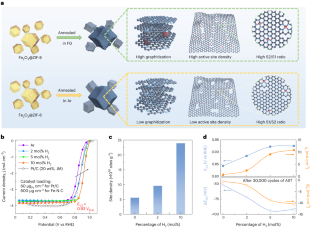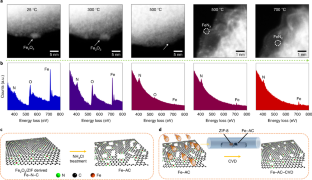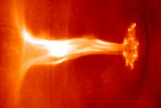2023-10-05 バッファロー大学(UB)
◆新しい研究では、水素を製造プロセスに添加することで、発電性能が白金に近い強力で効果的な触媒が作成される可能性があることが報告されています。これは、車両や航空機などの重要な輸送手段において、燃料電池技術が潜在的な汚染フリーな電力供給源として期待に応える重要な一歩となる可能性があります。
◆研究者は、低コストで効果的な触媒を作成できる一方で、その耐久性を確保するのは難しいというジレンマに対処する新たな手法を提案しています。
<関連情報>
- https://www.buffalo.edu/news/releases/2023/12/fuel-cell-catalysts-iron-nitrogen-carbon.html
- https://www.nature.com/articles/s41929-023-01062-8
- https://www.nature.com/articles/s41560-022-01062-1
熱活性化雰囲気を調整することで、Fe-N-C系酸素還元燃料電池触媒の活性と安定性のトレードオフが解消される Tuning the thermal activation atmosphere breaks the activity–stability trade-off of Fe–N–C oxygen reduction fuel cell catalysts
Yachao Zeng,Chenzhao Li,Boyang Li,Jiashun Liang,Michael J. Zachman,David A. Cullen,Raphael P. Hermann,E. Ercan Alp,Barbara Lavina,Stavros Karakalos,Marcos Lucero,Bingzhang Zhang,Maoyu Wang,Zhenxing Feng,Guofeng Wang,Jian Xie,Deborah J. Myers,Jean-Pol Dodelet & Gang Wu
Nature Catalysis Published:05 December 2023
DOI:https://doi.org/10.1038/s41929-023-01062-8

Abstract
Fe–N–C catalysts are the most promising platinum group metal-free oxygen-reduction catalysts, but they suffer from a low density of active metal sites and the so-called activity–stability trade-off. Here we report an Fe–N–C catalyst prepared by adding an optimal amount of H2 to the traditional inert atmosphere during the thermal activation. The presence of H2 significantly increases the total density of FeN4 sites, suppressing the unstable pyrrolic-N-coordinated S1 sites and favouring the stable pyridinic-N-coordinated S2 sites with shortened Fe–N bond lengths. We propose that the intrinsically stable S2 sites are probably arranged in well-graphitized carbon layers, and the S1 sites exist in less-graphitized carbon. H2 could remove unstable S1 sites and retain stable S2 sites during the pyrolysis to break the challenging activity–stability trade-off. The Fe–N–C catalyst in membrane electrode assemblies maintains a current density of 67 mA cm−2 at 0.8 V (H2–air) after 30,000 voltage cycles (0.60 to 0.95 V under H2–air), achieving encouraging durability and performance simultaneously.
燃料電池用高活性・高耐久性酸素還元触媒として、窒素-炭素コーティングを施した原子状分散鉄サイトを開発 Atomically dispersed iron sites with a nitrogen–carbon coating as highly active and durable oxygen reduction catalysts for fuel cells
Shengwen Liu,Chenzhao Li,Michael J. Zachman,Yachao Zeng,Haoran Yu,Boyang Li,Maoyu Wang,Jonathan Braaten,Jiawei Liu,Harry M. Meyer III,Marcos Lucero,A. Jeremy Kropf,E. Ercan Alp,Qing Gong,Qiurong Shi,Zhenxing Feng,Hui Xu,Guofeng Wang,Deborah J. Myers,Jian Xie,David A. Cullen,Shawn Litster & Gang Wu
Nature Energy Published:07 July 2022
DOI:https://doi.org/10.1038/s41560-022-01062-1

Abstract
Nitrogen-coordinated single atom iron sites (FeN4) embedded in carbon (Fe–N–C) are the most active platinum group metal-free oxygen reduction catalysts for proton-exchange membrane fuel cells. However, current Fe–N–C catalysts lack sufficient long-term durability and are not yet viable for practical applications. Here we report a highly durable and active Fe–N–C catalyst synthesized using heat treatment with ammonia chloride followed by high-temperature deposition of a thin layer of nitrogen-doped carbon on the catalyst surface. We propose that catalyst stability is improved by converting defect-rich pyrrolic N-coordinated FeN4 sites into highly stable pyridinic N-coordinated FeN4 sites. The stability enhancement is demonstrated in membrane electrode assemblies using accelerated stress testing and a long-term steady-state test (>300 h at 0.67 V), approaching a typical Pt/C cathode (0.1 mgPt cm−2). The encouraging stability improvement represents a critical step in developing viable Fe–N–C catalysts to overcome the cost barriers of hydrogen fuel cells for numerous applications.



